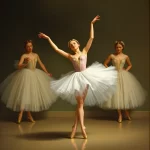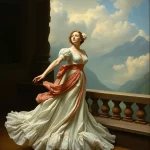Ballet: La Jolie Fille de Gand (Adolphe Adam, 1842)

Introduction
Ballet, a classical dance form known for its grace and precision, has a rich history filled with iconic works. One such work is “La Jolie Fille de Gand,” a ballet composed by Adolphe Adam in 1842. This ballet, choreographed by Albert, premiered on June 22, 1842, at the Paris Opera. The ballet tells a charming story set in the picturesque town of Ghent, revolving around themes of love, deception, and reconciliation.
Historical Background
Creation and Development
“La Jolie Fille de Gand” was created during a period when ballet was evolving rapidly, influenced by the Romantic movement that emphasized emotion, individualism, and nature. The ballet was inspired by local folklore and literary sources, which were common inspirations for Romantic ballets. Adolphe Adam, a prolific composer known for his work in ballet and opera, collaborated closely with the choreographer Albert and other key figures to bring this ballet to life.
Premiere and Reception
The ballet premiered on June 22, 1842, at the Paris Opera. The initial reception was positive, with critics and audiences praising the music, choreography, and the performances of the dancers. The ballet quickly became popular, leading to several notable early performances and revivals across Europe.
Synopsis of the Ballet
Act I Summary
The ballet opens in the bustling town of Ghent, where we meet the main characters. The beautiful and kind-hearted heroine, Marie, is introduced, along with her suitor, Pierre. The townspeople are preparing for a festival, and the atmosphere is lively and joyous. However, a rival suitor, Jacques, plots to win Marie’s heart through deceit.
Act II Summary
In the second act, Jacques’s schemes come to fruition, causing misunderstandings and conflicts between Marie and Pierre. The tension escalates as Pierre is falsely accused of a crime he did not commit. The act ends with Pierre being taken away, leaving Marie heartbroken.
Act III Summary
The final act brings resolution and reconciliation. Jacques’s deceit is uncovered, and Pierre is exonerated. The townspeople celebrate the truth coming to light, and Marie and Pierre are reunited. The ballet concludes with a grand festival, symbolizing the triumph of love and honesty.
Finale
The conclusion of the ballet is significant as it reinforces the themes of love, truth, and justice. The joyous festival at the end serves as a powerful reminder of the importance of integrity and the strength of true love.
Musical Composition
Composer’s Role
Adolphe Adam, a renowned composer of the 19th century, played a crucial role in the creation of “La Jolie Fille de Gand.” His music is known for its melodic richness and emotional depth, which perfectly complements the narrative of the ballet. Notable pieces within the score include the lively festival music and the poignant love themes.
Musical Themes and Motifs
The score of “La Jolie Fille de Gand” features recurring musical themes that enhance the narrative and emotional impact of the ballet. For instance, the love theme associated with Marie and Pierre recurs throughout the ballet, underscoring their relationship’s trials and triumphs. The music also employs leitmotifs to represent characters and emotions, adding depth to the storytelling.
Famous Recordings and Performances
Over the years, there have been several iconic recordings and performances of the ballet’s music. Notable recordings include those conducted by renowned maestros such as Richard Bonynge and John Lanchbery. These recordings have helped preserve and popularize Adam’s beautiful score.
Choreography and Dance
Choreographer’s Vision
Albert, the choreographer of “La Jolie Fille de Gand,” brought a unique vision to the ballet. His choreography emphasized expressive movements and dramatic storytelling, aligning with the Romantic era’s aesthetic. Albert introduced innovative dance sequences that highlighted the dancers’ technical prowess and emotional range.
Signature Dance Numbers
The ballet features several key dance numbers that are central to its narrative. The Pas de Deux between Marie and Pierre is a highlight, showcasing their love and connection. Solo performances by Marie and Jacques also stand out, reflecting their characters’ inner turmoil and desires. The choreography effectively mirrors the story’s emotional highs and lows.
Notable Interpretations
Over the years, different productions have interpreted and adapted the choreography of “La Jolie Fille de Gand” in various ways. Some productions have emphasized the ballet’s folkloric elements, while others have focused on its dramatic aspects. These interpretations have kept the ballet fresh and relevant for contemporary audiences.
Characters and Roles
Main Characters
The main characters in “La Jolie Fille de Gand” are:
- Marie: The beautiful and kind-hearted heroine.
- Pierre: Marie’s suitor, who is honest and brave.
- Jacques: The rival suitor, who is deceitful and cunning.
Supporting Characters
Important secondary characters include:
- The Townspeople: They play a significant role in the festival scenes and the unfolding of the plot.
- The Magistrate: A figure of authority who initially believes Jacques’s deceit but later helps in Pierre’s exoneration.
Famous Dancers
Several notable dancers have portrayed these roles over the years. Famous ballerinas such as Carlotta Grisi and Fanny Elssler have brought Marie to life with their exceptional performances. Renowned male dancers like Lucien Petipa have portrayed Pierre, adding depth and heroism to the character.
Cultural and Artistic Impact
Influence on Ballet and Dance
“La Jolie Fille de Gand” has had a significant influence on ballet and dance. Its success helped solidify Adolphe Adam’s reputation as a leading composer for ballet. The ballet’s themes and choreography have inspired other works and choreographers, contributing to the development of ballet as an art form.
Cultural Significance
The ballet holds a special place in popular culture and has been referenced in literature and other media. Its story of love and deception resonates with audiences, making it a timeless piece. The ballet has also been adapted into various forms, including film and theater productions.
Legacy and Revivals
“La Jolie Fille de Gand” continues to be performed and celebrated today. Major revivals and reinterpretations have kept the ballet alive for modern audiences. Companies around the world stage the ballet, ensuring its legacy endures.
Iconic Productions
Historic Productions
Some of the most famous historical productions of “La Jolie Fille de Gand” include those staged at the Paris Opera in the 19th century. Key figures involved in these productions were directors like Jules Perrot and dancers like Carlotta Grisi.
Contemporary Productions
Recent productions have brought new life to the ballet, incorporating modern elements while staying true to the original. These contemporary interpretations often feature updated set and costume designs, as well as innovative choreography that appeals to today’s audiences.
Production Design
The set, costume, and lighting design in various productions of “La Jolie Fille de Gand” have played a crucial role in bringing the story to life. Historical productions often featured elaborate sets and period costumes, while contemporary productions may use minimalist designs to focus on the dancers’ performances.
Critical Reception and Reviews
Initial Critical Response
At the time of its premiere, “La Jolie Fille de Gand” received positive reviews from critics. They praised the music, choreography, and performances, noting the ballet’s emotional depth and engaging story.
Modern Reviews
Contemporary critics and audiences continue to appreciate the ballet for its timeless themes and beautiful music. Modern reviews often highlight the ballet’s relevance and its ability to captivate audiences with its storytelling and choreography.
Fun Facts and Trivia
Behind-the-Scenes Stories
One interesting anecdote from the production of “La Jolie Fille de Gand” involves a last-minute change in the choreography due to an injury sustained by one of the lead dancers. This change led to the creation of a new dance sequence that became a highlight of the ballet.
Notable Performers
Famous dancers such as Carlotta Grisi and Lucien Petipa have been associated with “La Jolie Fille de Gand,” bringing their unique talents to the roles of Marie and Pierre.
Trivia
Did you know that Adolphe Adam composed the entire score for “La Jolie Fille de Gand” in just a few weeks? His ability to create beautiful music quickly was one of his many talents.
Conclusion
Summary of the Ballet’s Importance
“La Jolie Fille de Gand” is a significant work in the world of ballet, known for its beautiful music, engaging story, and innovative choreography. It has influenced other works and continues to be performed and celebrated today.
Final Thoughts
The ballet’s themes of love, deception, and reconciliation resonate with audiences, making it a timeless piece. Whether you are a seasoned ballet enthusiast or new to the art form, “La Jolie Fille de Gand” is a must-see performance that showcases the beauty and emotional depth of ballet.
FAQ
What is the central theme of this ballet?
The central theme of “La Jolie Fille de Gand” is the triumph of love and honesty over deceit and misunderstanding.
Who are the main characters in this ballet?
The main characters are Marie, Pierre, and Jacques.
What is the most famous dance number in this ballet?
The Pas de Deux between Marie and Pierre is one of the most famous dance numbers in the ballet.
How long does a typical performance of this ballet last?
A typical performance of “La Jolie Fille de Gand” lasts approximately two hours, including intermissions.
Are there any modern adaptations of this ballet?
Yes, there have been several modern adaptations and reinterpretations of the ballet, incorporating contemporary elements while staying true to the original story.
Why is this ballet considered important in the history of dance?
“La Jolie Fille de Gand” is considered important because of its beautiful music, innovative choreography, and its influence on other works and choreographers. It has played a significant role in the development of ballet as an art form.





